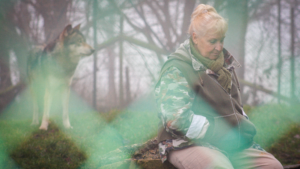
“Misha: A Mémoire of the Holocaust Years” was supposed to be Misha Defonseca’s magnum opus.
The memoir, published in 1997, recounts Defonseca’s supposed escape from Nazi clutches as a child after her parents’ deportation to Germany. After leaving her foster home, Defonseca wanders through the Belgian woods, eventually befriending and living amongst a pack of wolves.
The book was translated into 18 languages, optioned for a Disney film and landed a spot on Oprah Winfrey’s bookshelf as part of Oprah’s Book Club, though book sales in the United States were disappointingly low, making it a fresh story for today’s American audience.
Soon after the memoir’s modest international success, it — along with Defonseca — fell from grace. (Spoiler alert!) Defonseca’s publisher, Jane Daniel, found inconsistencies in Defonseca’s story, leading Daniel to enlist a team consisting of a genealogist, wolf-sanctuary founder and journalist, among others, to uncover the real story of Defonseca.
The fallout of Defonseca’s exposure as a fraud is unraveled in “Misha and the Wolves,” a true-crime documentary by Sam Hobkinson now streaming on Netflix.
The documentary introduces the story’s players, as a series of characters — each with a connection to Defonseca — relay their part of the narrative. Defonseca, a stoic older woman with pulled-back gray hair and outdated makeup, shares her thoughts, too.
Hobkinson spends the first third of the film building suspense, stitching together interviews and b-roll to leave the audience incredulous of Defonseca’s story, with Daniel giving the bulk of the detailing.
After Daniel reveals Misha’s story as fraudulent, Hobkinson tries to shock the audience: He shoots a scene of the woman in the first half of the film who spoke as Defonseca sitting in a makeup chair, removing a wig and revealing herself to be nothing more than an actor.
Hobkinson’s clever narrative tool falls short, however, due to one-dimensional acting from “Defonseca,” a character known to others as eccentric and warm. Her lines feel scripted and unoriginal, and her perspective does not feel special enough to warrant her presence in the documentary.
Moreover, to pull off this stunt the documentary holds off on revealing the “real” Defonseca’s face, hiding photographs and video footage from the audience.
For a film that sets out to correct an untruth, the lack of footage of Defonseca during the first half of the film is confusing and is representative of Hobkinson’s reliance on telling his story through interviews, as opposed to compelling footage.
The documentary is packed with B-roll footage of a fictionalized Defonseca hiking through the woods as a young girl or of the film crew dismantling the set of the fake Defonseca’s actor’s home. These shots were a missed opportunity to not only show old footage, but to give the audience an inside look at the process of uncovering a true mystery.
In fact, “Misha and the Wolves” shines brightest when it walks the audience through uncovering the truth.
Much of Defonseca’s story is debunked by Evelyne Haendel, an actual Belgian Holocaust survivor. Haendel, a genealogist, dives into archives and finds the truth about Defonseca. When she speaks to the camera, Haendel feels honest, vulnerable. The shots of her traveling around Belgium, pouring over old records, being surprised with what she finds, transforms “Misha and the Wolves” into more than just an entertaining documentary, but a real mystery that needs dissecting.
Haendel’s astonishment at the lengths Defonseca went to spin her story is what makes the film all the more engaging. In addition to making sense of why Defonseca chose to falsify her story, Haendel had to make sense of why someone would choose to pretend to be a Holocaust survivor, of all people.
To see the distress Defonseca’s falsehood caused for a Shoah survivor further antagonizes Defonseca and is a profound reminder to the audience that the Holocaust remains off-limits for appropriation.
The end of the film takes yet another turn, as it makes a half-hearted attempt to redeem Defonseca, who is still alive, and, evidently, truly an animal lover. A shaky attempt to add nuance to the story, Defonseca’s redemption detracted from the harm she caused to those who read and were affected by her book. It was an out-of-place addition to the film that had potential, but was not executed with enough intention and felt like an afterthought.
The story of Defonseca is an eerie one. It warrants a conversation about the validity of memory and the complex morality of those who have lied or made other bad choices because of their own past strife. Though Defonseca’s story is worth knowing, perhaps Hobkinson wasn’t the best choice to tell it.
Unlike Defonseca, who uses grandeur and charisma to convince her audience of lies, “Misha and the Wolves” does nearly the opposite: It tries to set the story straight, but lacks the imagination to truly sell its viewers.
[email protected]; 215-832-0741



